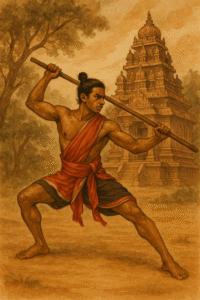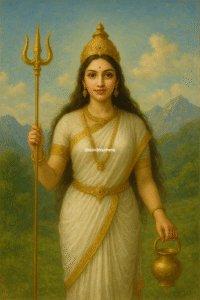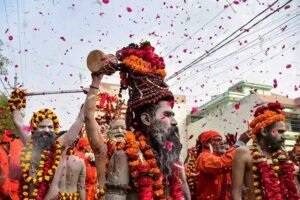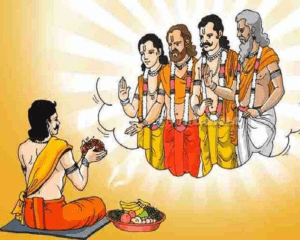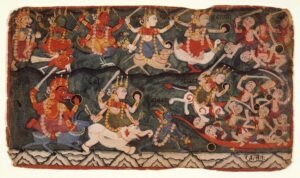Maa Kalaratri, the seventh manifestation of Goddess Durga, is revered for her fierce and protective form. She is also considered a form of Parvati, the consort of Lord Shiva. The earliest mention of Maa Kalaratri is found in the Durga Saptashati (chapters 81 to 93), a part of the Markandeya Purana, the oldest known text dedicated to the goddess Durga.
Widely recognized as one of the destructive forms of the Mother Goddess, Maa Kalaratri shares her ferocity with other divine forms like Kali, Mahakali, Bhadrakali, Bhairavi, Mrityu-Rudrani, Chamunda, Chandi, Durga, Raudri, and Dhumravarna. Her intense energy symbolizes the destruction of evil and protection of the righteous.
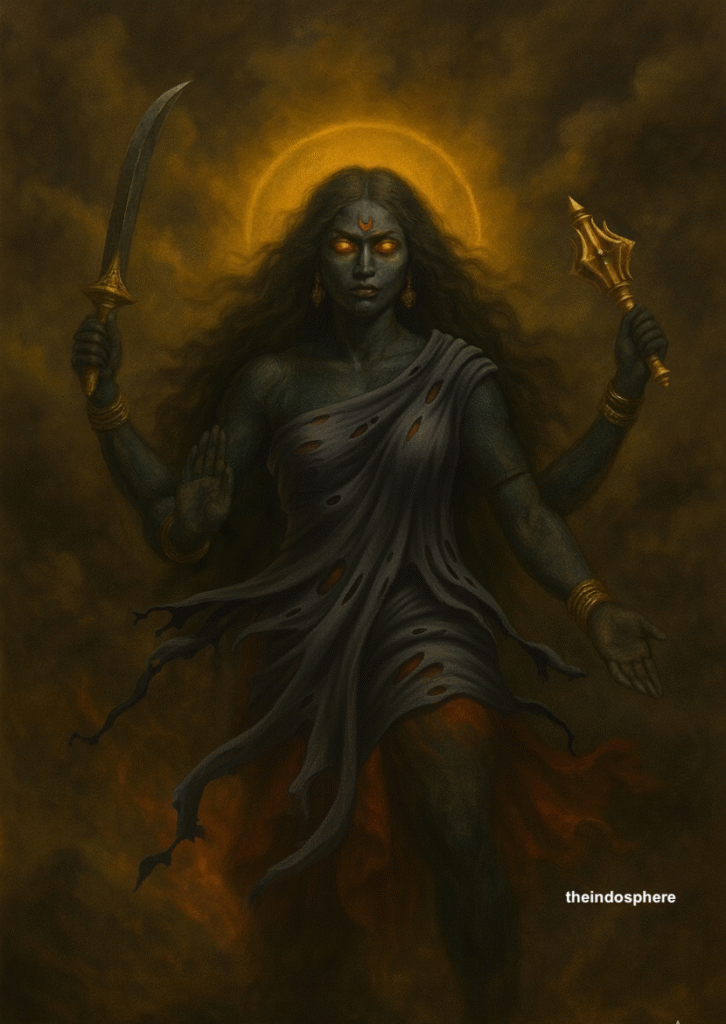
Who is Maa Kalaratri?
Maa Kalaratri is the fiercest and most aggressive form of Goddess Durga. Depicted with four arms, she is the embodiment of both fear and protection. Her upper right hand bestows boons upon her devotees, while her lower right hand offers protection and fearlessness. In her upper left hand, she wields a fearsome khadga (sword), and in her lower left hand, she carries an iron club, which she uses to vanquish evil forces.
Her appearance is awe-inspiring: her hair flows wildly, and she wears a sparkling bead necklace that shines like lightning. Maa Kalaratri has three intense eyes, and fire erupts from her nostrils, representing her deep anger towards evil. She rides a donkey, which, although often viewed as a lowly animal, symbolizes her protective nature towards the most vulnerable beings. By riding the donkey, Maa Kalaratri sends a message of compassion, urging care and respect for all living creatures, especially the most abused and abandoned.
Despite her terrifying form, Maa Kalaratri is also known as Shubhankari, meaning the auspicious one. She destroys negativity and evil forces but blesses her devotees with prosperity, protection, and peace.
A Narrative about Maa Kalaratri
Hindu mythology tells the tale of how Devaloka, the realm of the demigods, was once invaded by two powerful demons named Shumbha and Nishumbha. These demons defeated the devtas, forcing Indra, the king of the gods, and his fellow deities to flee their realm and seek refuge in the Himalayas. Desperate, the gods turned to Lord Shiva and pleaded for help in reclaiming their kingdom.
In response to their prayers, Goddess Parvati took on a fierce form known as Goddess Chandika to defeat the demons. Shumbha and Nishumbha, however, sent their generals, Chand and Mund, to challenge Chandika. At this moment, Parvati transformed into Maa Kalaratri (or Kali) to battle these demons. According to the Devi Bhagavata Purana, Maa Kalaratri grabbed Chand and Mund by their hair and decapitated them, earning her the name Chamunda (the one who slays Chand and Mund).
Following this battle, the demon Raktbeej, who had a special boon that allowed his blood to generate clones of himself whenever it touched the ground, confronted Maa Kalaratri. With great strategy and determination, the goddess drank his blood to prevent it from falling and multiplying his clones, thus completely defeating him. This act left her tongue stained blood-red, a symbol of her unstoppable power.
After defeating Raktbeej, Maa Kalaratri turned her attention to Shumbha and Nishumbha, ultimately vanquishing them and restoring Indraloka to Indra and the devtas. Her actions freed the gods from their suffering, showcasing her role as the destroyer of evil and the restorer of balance in the universe.
Famous Temples of Maa Kalaratri in India
Maa Kalaratri is worshipped across India, and several temples are dedicated to her fierce form. Some of the most famous temples are:
- Kalaratri Temple, Varanasi (Uttar Pradesh)
Located in the holy city of Varanasi, Maa Kalaratri Temple is a significant site for devotees seeking blessings from the fierce goddess. Known for its sacred atmosphere, devotees visit this temple during Navratri to offer prayers for protection and spiritual guidance. It is believed that worshipping Maa Kalaratri in Varanasi helps remove the fear of death and grants inner peace. - Kalratri Devi Temple, Almora (Uttarakhand)
Nestled in the scenic hills of Uttarakhand, the Kalratri Devi Temple in Almora is dedicated to the fierce goddess. Known for its powerful spiritual energy, this temple draws pilgrims from all over the country, especially during the festival of Navratri. The serene yet powerful ambiance of the temple makes it a perfect place for meditation and spiritual reflection. - Chamunda Devi Temple, Kangra (Himachal Pradesh)
Maa Kalaratri is worshipped in her form as Chamunda at this temple in Kangra Valley, which is one of the most renowned Shakti Peethas. This ancient temple holds great significance as it is believed that Chamunda Devi killed the demons Chand and Mund at this very site. Pilgrims visit this temple in large numbers, seeking the goddess’s blessings to overcome fear, evil forces, and life’s difficulties. - Shri Kalaratri Devi Mandir, Madhya Pradesh
Located in the central part of India, this temple is dedicated to Maa Kalaratri and is an important spiritual site for devotees. The temple is especially vibrant during Navratri when devotees gather to seek her blessings for strength and protection. Offering hibiscus flowers and performing special rituals at this temple are believed to please the goddess. - Kalighat Temple, Kolkata (West Bengal)
Although dedicated to Maa Kali, the Kalighat Temple is often associated with Maa Kalaratri as well due to the shared symbolism of fierce protective power. The temple is one of the 51 Shakti Peethas and a significant pilgrimage site. Worshippers flock here to invoke the goddess’s blessings for courage, wisdom, and the destruction of evil.
Pooja and Mantras of Maa Kalaratri
On the seventh day of Navratri, devotees offer kheer (a rice pudding) and seasonal fruits to Maa Kalaratri as part of their prayers. During meditation, devotees can chant the following mantra to seek the goddess’s blessings and protection:
Mantra: “Oṃ Aiṃ Hrīṃ Klīṃ Chamundayai Vichchai Uṃ Kalaratri Daivye Namaha”
मंत्र-
ओम ऐं ह्रीं क्लीं चामुण्डायै विच्चै ऊं कालरात्रि दैव्ये नम:।’
Additionally, another sacred chant that is often recited in her honor is:
एकवेणी जपाकर्णपूरा नग्ना खरास्थिता।
लम्बोष्ठी कर्णिकाकर्णी तैलाभ्यक्तशरीरिणी॥
वामपादोल्लसल्लोहलताकण्टकभूषणा।
वर्धनमूर्धध्वजा कृष्णा कालरात्रिर्भयंकरी॥
Ekaveni Japakarnapura Nagna Kharaasthitaa |
Lamboshthi Karnikakarni Tailabhyaktasharirini ||
Vamapadol Lasallohalatak Kantakbhushanaa |
Vardhanamurdhadhwajaa Krishna Kalaratrirbhayankari ||
Hibiscus flowers, which are rich in red color, are especially sacred to Maa Kalaratri. Devotees offer 108 hibiscus flowers during the puja, as it is believed that these flowers are highly pleasing to the goddess and attract her divine grace.
Why is Maa Kalaratri Worshipped?
Maa Kalaratri holds divine control over the Pingala Nadi, a significant channel of pranic (life force) energy in the body. Her worship on the seventh day of Navratri helps devotees tap into deeper levels of spiritual consciousness. By meditating on the Sahasrara (the crown chakra), devotees can enhance their spiritual power, develop foresight, and gain the blessings of Maa Kalaratri.
Maa Kalaratri is also known as the bestower of siddhis (spiritual powers) and offers both Bhoga (worldly enjoyment) and Moksha (liberation) to her devotees. Through her fierce energy, she removes obstacles and destroys ignorance, allowing devotees to achieve spiritual growth and material success.
Her worship not only helps to destroy internal and external negativity but also allows the devotee to attain fearlessness, clarity of thought, and divine protection.
Maa Kalaratri, despite her terrifying appearance, embodies both destruction and benevolence. She is worshipped to overcome fear, negative energies, and adversaries. Her compassion towards her devotees is boundless, and she rewards them with peace, prosperity, and ultimate liberation.


